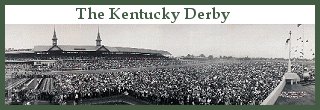
By Kelly Coughlin and Christie Keith Often called the most exciting two minutes in sports, the Kentucky Derby is long on history and pageantry. Each year, the first Saturday in May is reserved for Derby Day. From the tension packed paddock area, to the playing of "My Old Kentucky Home," to the loading at the starting gate and electrifying start, the Kentucky Derby is an event not to be missed. At each Derby meeting, the most coveted piece of real estate is the precious few furlongs of the stretch run at Churchill Downs in Louisville, KY. A race like no others, the Derby is the first step for three year old thoroughbreds competing for the coveted Triple Crown and three year old Horse of the Year titles. At a mile and a quarter on dirt, the Kentucky Derby is a true test for these young athletes. Unlike comparable sports championships, the Kentucky Derby comes early in the season, rather than at the end of a grueling series of games and playoffs. Being early means that the Derby brings the news. It is the first time that the best horses in the crop of three-year-olds meet. Three-year-old horses are like college basketball players, just coming into their full maturity, but not as strong and fast as they will be at four. Before the first Saturday in May, they have been racing in Florida, California, New York, Arkansas, Louisiana and over at Keeneland in Lexington, many of them studiously avoiding each other before the big race. Each year on the first Saturday in May, a field of three-year-olds contend for the winner's circle and a chance at the Triple Crown.
Did You Know? Kentucky Derby Trivia By Kelly Coughlin A horse named Aristides, with Oliver Lewis up, was the first winner of the what is now called the Kentucky Derby. He ran the race in 2:37.75 over a mile and a half course. The distance was changed to a mile and a quarter in 1896. The fastest Derby was in 1973, by Secretariat, who broke the two-minute mark and blazed the mile and a quarter in 1:59.4. Remarkably, each quarter mile split was faster than the one preceding it. No other horse has broken the two minute barrier in the Derby. Dominated by the boys, geldings and stallions, the fillies have done some winning at the Derby too. Three fillies have won the Kentucky Derby: Favored Regret in 1915, Genuine Risk in 1980 and Winning Colors in 1988. Twenty one horses, from Day Star in 1878 to Winning Colors a hundred and ten years later, have led the race wire-to-wire. Many great horses - Man o' War, Seabiscuit, Kelso, Buckpasser, John Henry, Cigar - never raced in the Derby; others, such as Native Dancer, Nashua, Bold Ruler, Round Table and Alydar, ran and didn't win. Willie Shoemaker will never live down what he did in the Kentucky Derby in 1957. Leading on Gallant Man, he mistakenly pulled up 110 yards before the finish line and was passed by Iron Liege. But Shoemaker will also never be forgotten for what he did at Churchill Downs in 1986, when he became the oldest jockey to win the Kentucky Derby. He was 54 when he rode Ferdinand, trained by 73-year-old Charlie Whittingham, to the Derby win. Two jockeys, Eddie Arcaro and Bill Hartack, have each ridden five Kentucky Derby winners. Eight horses that have won the Kentucky Derby have been bred by Calumet Farm in Kentucky. Jockey Eddie Arcaro rode to two Triple Crown wins. The first on Whirlaway in 1941, and then on Citation in 1948. The first woman to ride in the Kentucky Derby was Diane Crump on May 2, 1970. A racehorse averages a weight loss of between 15 and 25 pounds during a race. Racehorses have been known to wear out new shoes in one race. No matter when a racehorse is born, they all "become" a year older on New Year's Day.
Horse-racing regulations state that no race horse's name may contain more than eighteen letters. Names that are too long would be cumbersome on racing sheets.
|